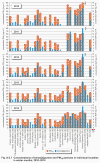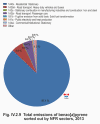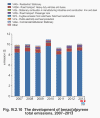IV.2 BENZO[A]PYRENE
IV.2.1 Air pollution caused by benzo[a]pyrene in the year 2014
Air pollution caused by benzo[a]pyrene is one of the main problems of air quality protection in the Czech Republic. In 2014 the annual average concentrations of benzo[a]pyrene exceeded the limit value at more than 74 % of stations (i.e. at 23 of the total number of 31 stations with a sufficient number of measurements for the evaluation). The year-on-year comparison shows a slight increase because in 2013 exceedances occurred at 68 % of stations (i.e. at 21 of 31 stations with sufficient data for the evaluation). However, the average annual concentrations in 2014 compared to 2013 (evaluated on the basis of a group of stations for which data were available for both 2013 and 2014) decreased at more than a three-quarters of the localities. Similarly, the average annual concentration (averaged for the same group of stations at which measurements were carried out both in 2013 and 2014) was lower in 2014 (1.98 ng.m-3) in comparison with the year 2013 (2.10 ng.m-3).
A number of towns and smaller settlements were evaluated, similarly as in the previous years, as territories where the limit value was exceeded (Fig. IV.2.1). In 2014 the limit value was exceeded in 10.7 % of the territory of the Czech Republic (in 2013 in 17.4 % of the territory of the Czech Republic). The percentage of inhabitants exposed to limit-exceeding concentrations of benzo[a]pyrene in 2014 is estimated at 51.1 % (in 2013 approx. 54.5 %).
It is necessary to consider that the estimate of the fields of annual average benzo[a]pyrene concentrations (Fig. IV.2.1), in comparison with other mapped pollutants, is burdened with the greatest uncertainties resulting from insufficient measurement density. The uncertainty of the map is influenced also by an insufficient number of measurements at rural regional stations. However, there is another contribution to the uncertainty resulting from the absence of measurements in small settlements in the Czech Republic which would represent the fundamental influence of local heating as concerns ambient air pollution caused by benzo[a]pyrene. Consequently, the assessment of the year-to-year change of the share of the area and population affected by limit-exceeding concentrations of benzo[a]pyrene is burdened with greater uncertainty. More details on the uncertainty of mapping are presented in Annex I.
The highest annual average concentration in 2014 was measured, similarly as in the previous years, at the industrial locality Ostrava-Radvanice ZÚ (9.3 ng.m-3) with almost ninefold exceedance of the level of the limit value. Above-limit concentrations were reached also at other three industrial localities and at almost 74 % of urban and suburban background stations. As concerns traffic stations, benzo[a]pyrene concentrations are measured at two stations only, and both of them exceeded the limit value (Table XIII.6). The exceedance of the limit value for benzo[a]pyrene at most stations is given by a more or less regular distribution of the main source of benzo[a]pyrene emissions, which is household heating. The highest concentrations are measured, similarly as for other pollutants, in the agglomeration of O/K/F-M due to the highest emission loads within the Czech Republic and cross-border transport from Poland (see Chapter IV.2.3 for more details).
The highest concentrations of benzo[a]pyrene in the Czech Republic are measured every year at the stations Ostrava-Radvanice ZÚ, Ostrava-Radvanice OZO, Ostrava-Přívoz, Český Těšín and Ostrava-Mariánské Hory (Fig. IV.2.8). The unfavourable situation in the Ostrava-Karviná area and the year-round influence of emissions are illustrated by the fact that in summer periods, when benzo[a]pyrene concentrations at other stations reach levels around the margin of detection (0.04 ng.m-3), daily concentrations even exceeding 1 ng.m-3 are recorded at the above stations (e.g. Ostrava-Přívoz 2.97 ng.m-3 on 29/7/2014, Český Těšín 2.50 ng.m-3 on 3/5/2014, Ostrava-Radvanice ZÚ 19.00 ng.m-3 on 5/7/2014, Ostrava-Radvanice OZO 11.00 ng.m-3 on 28/8/2014 and Ostrava-Mariánské Hory 6.30 ng.m-3 on 16/8/2014). The presented values of daily concentrations of benzo[a]pyrene in the summer period of 2014 at these stations were higher than daily concentrations of benzo[a]pyrene measured in the summer period of 2013.
Above-limit concentrations of benzo[a]pyrene probably also affect municipalities where its levels are not routinely monitored. This fact is repeatedly confirmed by measurements taken at new localities, e.g. Brušperk, Ludgeřovice or Valašské Meziříčí. The localities Brušperk (4.7 ng.m-3) and Ludgeřovice (5.4 ng.m-3), where monitoring in the year 2014 was subsidized from the budget of the Moravia-Silesia Region1, lie near the city of Ostrava, and are therefore exposed to the influence of both the industrial region and local heating and transport. By contrast, the station in Valašské Meziříčí, which is in operation since 2013, is situated on the premises of a school and is not directly influenced by emissions of benzo[a]pyrene. This locality, with annual average concentration of 2.1 ng.m-3 (2.9 ng.m-3 in 2013), nevertheless still ranks among strongly polluted localities.
Benzo[a]pyrene concentrations show a marked annual course (Figs. IV.2.5 and IV.2.8) with maximum levels in the winter period and minimum levels in the summer period. The increased concentrations in the winter period are related with the increased PAH concentrations from seasonal anthropogenic sources – from local heating (i.e. from the most significant source of benzo[a]pyrene emissions of polycyclic aromatic hydrocarbons, hereafter referred to as PAH – Fig. IV.2.9). PAH emissions have another significant source, which is traffic. Moreover, in the winter period, PAH emissions are increased due to cold starts. Further causes of increased concentrations include deteriorated dispersion conditions in the winter period, simpler gas-particle conversion at low temperatures and lower photochemical decomposition of PAH. In summer periods, on the contrary, the concentrations decrease due to better dispersion conditions, increased chemical and photochemical decomposition of PAH under higher intensity of solar radiation and high temperatures and, of course, due to the reduction of emissions from anthropogenic sources (Li et al. 2009; Ludykar et al. 1999; Teixeira et al. 2012).
In 2014 the highest concentrations were measured in the months of January–March and October–December (Fig. IV.2.6), especially as a result of low temperatures and unfavourable dispersion conditions over the whole winter period. From the perspective of dispersion conditions, the year 2014 was more favourable and above-normal temperature wise (see Chapter III), which together with a lower intensity of heating led to lower concentrations compared to previous years.
IV.2.2 Development of benzo[a]pyrene concentrations
Trends of average annual concentrations of benzo[a]pyrene since the year 2006 are presented. The national average for the levels of this pollutant shows long-term exceedances of the limit value (more than double levels, Fig. IV.2.4). The highest benzo[a]pyrene concentrations were measured in 2006 (more than threefold exceedance of the limit value) due to deteriorated meteorological and dispersion conditions. Since 2007 concentrations of benzo[a]pyrene have fluctuated and have not shown any marked trend. Based on the year-on-year comparison between 2013 and 2014, it can be stated that the concentrations decreased slightly by almost 5.5 % on national average. This decrease, however, is narrowly associated with the meteorological situation over the whole course of the year, and no conclusions regarding emission sources can be drawn from it. The highest concentrations are reached at industrial localities. The above-limit concentrations, however, occur also at urban and suburban stations (Figs. IV.2.5 and IV.2.6). As already mentioned, insufficient number of measurements at rural localities does not allow the estimation of the level of benzo[a]pyrene concentration in small settlements. Nevertheless, on the basis of the structure of emission sources and e.g. the results of the study by Krejčí (2012), it may be stated that the concentrations there reach the limit-exceeding levels as well. The relationship between concentrations of benzo[a]pyrene and PM10 particles in summer months of 2010–2014 is presented in Fig. IV.2.7.
IV.2.3 Emissions of benzo[a]pyrene
Emissions of PAH in the ambient air pollution sphere represented by benzo[a]pyrene are produced almost exclusively by combustion processes during which organic combustible substances are not sufficiently oxidized. Benzo[a]pyrene is the product of insufficient combustion at temperatures between 300 and 600 °C. Therefore, the most significant sources include the combustion of solid fuels in low-output boilers, primarily in households, and transport.
Sector 1A4bi-Residential stationary combustion contributed to benzo[a]pyrene emissions in 2013 by 87.1 % on the country-wide scale (Fig. IV.2.9). This high share was caused by the combustion of solid fuels, mainly coal, in old types of boilers (under-fire boilers, over-fire boilers). The expert estimates states that non-gasification boilers and lower combustion boilers represent up to 85 % of all solid fuels combustion plants in households (Bufka 2011). The influence of sectors 1A3biii-Road transport: Heavy duty vehicles and buses, and 1A3bi-Road transportation: passenger cars is estimated at 10.2 %. Other significant sources of benzo[a]pyrene emissions are found in the sectors 1A2a-Stationary combustion in manufacturing industries and construction: Iron and steel (agglomeration/sintering belts) and 1B1b-Solid fuel transformation (coke-oven battery leaks).
In individual regions of the Czech Republic, the
contributions of individual types of sources to total emissions
varies depending on the particular mix of sources in the given
area. Due to the dominant share of the local household heating
sector 1A4bi, benzo[a]pyrene, emissions are distributed
throughout the area of the Czech Republic with residential
development (Fig. IV.2.11), and their amount in the period of
2007–2013 depended especially on the temperature character of
each heating season (Fig. IV.2.10). The influence of traffic is
evident mainly along highways and in the territory of big cities.
The greatest burden of benzo[a]pyrene emissions is recorded in
the O/K/F-M agglomeration due to the share of iron and steel
production plants and associated coke plants.
Tab. XIII.6 Stations with the highest values of annual average
concentrations of
benzo[a]pyrene in the ambient air

Fig. IV.2.1 Field of annual average concentration of benzo[a]pyrene,
2014

Fig. IV.2.2 Annual average concentrations of benzo[a]pyrene in
the ambient air at selected stations, 2004–2014

Fig. IV.2.3 Five-year average of annual average concentrations
of benzo[a]pyrene, 2010–2014

Fig. IV.2.4 Trends of benzo[a]pyrene annual characteristics in
the Czech Republic, 2006–2014

Fig. IV.2.5 Annual course of average monthly concentrations of
benzo[a]pyrene (averages for the given type of station), 2014

Fig. IV.2.6 Average monthly concentrations of benzo[a]pyrene and
PM10 particles at individual localities in winter months, 2014

Fig. IV.2.7 Concentrations of benzo[a]pyrene and PM10 particles
at individual localities in winter months, 2010–2014

Fig. IV.2.8 24-hour concentrations at the stations with the
highest annual concentrations of benzo[a]pyrene, 2014

Fig. IV.2.9 Total emissions of benzo[a]pyrene sorted out by NFR
sectors, 2013

Fig. IV.2.10 The development of benzo[a]pyrene total emissions,
2007–2013

Fig. IV.2.11 Benzo[a]pyrene emission density from 5x5 km squares,
2013
1For
the detailed annual evaluation, see
www.chmi.cz